A Review of Uncertain Decision-Making Methods in Energy Management Using Text Mining and Data Analytics
Abstract
1. Introduction
- Q1-
- What type of research has been performed in the fields of energy and sustainability in recent years?
- Q2-
- What are the main trends observed and the potential reasons for their emergence?
- Q3-
- Which techniques have been used to formalize and analyze the uncertainty faced by decision-makers?
2. Literature Review
2.1. Energy Research Methods
2.2. Decision-Making Methods Dealing with Uncertainty
2.2.1. Analytical Hierarchy Process
2.2.2. Analytic Network Process
2.2.3. Technique for Order Preferences by Similarity to Ideal Solutions
2.2.4. Best–Worst Method
2.2.5. MULTIMOORA
2.2.6. Complex Proportional Assessment
2.2.7. Weighted Aggregated Sum Product Assessment
2.2.8. PROMETHEE and FPROMETHEE
2.3. Text Mining Methods
2.3.1. Text Clustering
2.3.2. Topic Modeling
2.3.3. Text Classification
3. Research Framework
3.1. Data Collection
3.2. Data Analytics
- (a)
- Through the pre-processing stage, we removed punctuations, numbers, and stop words, and implemented tokenization, lemmatization, and other small improvements. Tokenization is the process of protecting sensitive data by replacing it with an algorithmically generated number called a token, and lemmatization is a text normalization method used to replace the words with root words or words with similar context.
- (b)
- We identified the most frequent words and applied a word cloud and a word co-occurrence analysis.
- (c)
- Text clustering is applied to the titles, abstracts, keywords, and research methodologies of the articles.
- (d)
- Topic modeling focuses on the coherence of article titles and keywords, together with research methods.
4. Findings
4.1. Pre-Processing and Frequency Words
4.2. Text Mining Analysis
5. Discussion and Policy Implications
Scope of the Analysis
6. Conclusions
Author Contributions
Funding
Conflicts of Interest
References
- He, Y.; Guo, S.; Cui, R. Energy strategy develop dominant decision-making based on AHP. In Proceedings of the 2011 International Conference on Mechatronic Science, Electric Engineering and Computer (MEC), Jilin, China, 19–22 August 2011; Institute of Electrical and Electronics Engineers (IEEE): Piscataway, NJ, USA, 2011; pp. 1706–1709. [Google Scholar]
- Wu, Z.; Xu, J. Predicting and optimization of energy consumption using system dynamics-fuzzy multiple objective programming in world heritage areas. Energy 2013, 49, 19–31. [Google Scholar] [CrossRef]
- Tannirandon, A.; Gerdsri, N. Energy planning for sustainable development–challenge and experience sharing from Thailand. In Proceedings of the IEEE International Conference on Management of Innovation and Technology (ICMIT), Bangkok, Thailand, 19–22 September 2016; pp. 115–120. [Google Scholar]
- Sellak, H.; Ouhbi, B.; Frikh, B. Energy planning under uncertain decision-making environment: An evidential reasoning approach to prioritize renewable energy sources. Intel. Artif. 2017, 20, 21. [Google Scholar] [CrossRef][Green Version]
- Boran, F.E.; Boran, K.; Menlik, T. The Evaluation of Renewable Energy Technologies for Electricity Generation in Turkey Using Intuitionistic Fuzzy TOPSIS. Energy Sources Part B Econ. Plan. Policy 2012, 7, 81–90. [Google Scholar] [CrossRef]
- Streimikiene, D.; Sliogeriene, J.; Turskis, Z. Multi-criteria analysis of electricity generation technologies in Lithuania. Renew. Energy 2016, 85, 148–156. [Google Scholar] [CrossRef]
- Kaya, T.; Kahraman, C. Multicriteria renewable energy planning using an integrated fuzzy VIKOR & AHP methodology: The case of Istanbul. Energy 2010, 35, 2517–2527. [Google Scholar] [CrossRef]
- Sellak, H.; Ouhbi, B.; Frikh, B.; Palomares, I. Towards next-generation energy planning decision-making: An expert-based framework for intelligent decision support. Renew. Sustain. Energy Rev. 2017, 80, 1544–1577. [Google Scholar]
- Baumann, M.; Weil, M.; Peters, J.F.; Chibeles-Martins, N.; Moniz, A.B. A review of multi-criteria decision making approaches for evaluating energy storage systems for grid applications. Renew. Sustain. Energy Rev. 2019, 107, 516–534. [Google Scholar] [CrossRef]
- Sengul, U.; Eren, M.; Shiraz, S.E.; Gezder, V.; Şengül, A.B. Fuzzy TOPSIS method for ranking renewable energy supply systems in Turkey. Renew. Energy 2015, 75, 617–625. [Google Scholar] [CrossRef]
- Trivyza, N.; Rentizelas, A.A.; Theotokatos, G. A novel multi-objective decision support method for ship energy systems synthesis to enhance sustainability. Energy Convers. Manag. 2018, 168, 128–149. [Google Scholar] [CrossRef]
- Mardani, A.; Zavadskas, E.K.; Khalifah, Z.; Zakuan, N.; Jusoh, A.; Nor, K.M.; Khoshnoudi, M. A review of multi-criteria decision-making applications to solve energy management problems: Two decades from 1995 to 2015. Renew. Sustain. Energy Rev. 2017, 71, 216–256. [Google Scholar] [CrossRef]
- Nabeeh, N.A.; Abdel-Basset, M.; El-Ghareeb, H.; Aboelfetouh, A. Neutrosophic Multi-Criteria Decision Making Approach for IoT-Based Enterprises. IEEE Access 2019, 7, 59559–59574. [Google Scholar] [CrossRef]
- Sadok, W.; Angevin, F.; Bergez, J.-E.; Bockstaller, C.; Colomb, B.; Guichard, L.; Reau, R.; Doré, T. Ex ante Assessment of the Sustainability of Alternative Cropping Systems: Implications for Using Multi-criteria Decision-Aid Methods—A Review. Sustain. Agricult. 2009, 753–767. [Google Scholar]
- Mousavi, M.M.; Lin, J. The application of PROMETHEE multi-criteria decision aid in financial decision making: Case of distress prediction models evaluation. Expert Sys. App. 2020, 159, 113438. [Google Scholar] [CrossRef]
- Zopounidis, C.; Doumpos, M. Multi-criteria decision aid in financial decision making: Methodologies and literature review. J. Multi-Criteria Decis. Anal. 2002, 11, 167–186. [Google Scholar] [CrossRef]
- Satty, T.L. The Analytic Process; McGraw-Hill: New York, NY, USA, 1980. [Google Scholar]
- Tavana, M.; Zareinejad, M.; Di Caprio, D.; Kaviani, M.A. An integrated intuitionistic fuzzy AHP and SWOT method for outsourcing reverse logistics. Appl. Soft Comput. J. 2016, 40, 544–557. [Google Scholar] [CrossRef]
- Papapostolou, A.; Karakosta, C.; Apostolidis, G.; Doukas, H. An AHP-SWOT-Fuzzy TOPSIS Approach for Achieving a Cross-Border RES Cooperation. Sustainability 2020, 12, 2886. [Google Scholar] [CrossRef]
- Vishnu, C.R.; Sridharan, R.; Kumar, P.N.R. Supply chain risk inter-relationships and mitigation in Indian scenario: An ISM-AHP integrated approach. Int. J. Log. Sys. Manag. 2019, 32, 548–578. [Google Scholar] [CrossRef]
- Leung, K.H.; Mo, D.Y. A Fuzzy-AHP Approach for Strategic Evaluation and Selection of Digital Marketing Tools. In Proceedings of the 2019 IEEE International Conference on Industrial Engineering and Engineering Management (IEEM), Macau, China, 15 December 2019; Institute of Electrical and Electronics Engineers (IEEE): Piscataway, NJ, USA, 2019; pp. 1422–1426. [Google Scholar]
- Yücenur, G.N.; Vayvay, Ö; Demirel, N.Ç. Supplier selection problem in global supply chains by AHP and ANP approaches under fuzzy environment. Int. J. Adv. Manuf. Technol. 2011, 56, 823–833. [Google Scholar] [CrossRef]
- Shabani, B.; Dukovski, V. Application of Decision Making Method (AHP) in Reverse Engineering and Additive Manufacturing Technologies; UBT: Pristina, Kosovo, 2019. [Google Scholar]
- Ramos-Quintana, F.; Tovar-Sánchez, E.; Saldarriaga-Noreña, H.; Sotelo-Nava, H.; Sanchez-Hernandez, J.P.; Castrejón-Godínez, M.-L. A CBR–AHP Hybrid Method to Support the Decision-Making Process in the Selection of Environmental Management Actions. Sustainability 2019, 11, 5649. [Google Scholar] [CrossRef]
- Chou, Y.-C.; Yen, H.-Y.; Dang, V.T.; Sun, C.-C. Assessing the Human Resource in Science and Technology for Asian Countries: Application of Fuzzy AHP and Fuzzy TOPSIS. Symmetry 2019, 11, 251. [Google Scholar] [CrossRef]
- Wang, B.; Song, J.; Ren, J.; Li, K.; Duan, H.; Wang, X. Selecting sustainable energy conversion technologies for agricultural residues: A fuzzy AHP-VIKOR based prioritization from life cycle perspective. Resour. Conserv. Recycl. 2019, 142, 78–87. [Google Scholar] [CrossRef]
- Saaty, R. The analytic hierarchy process—What it is and how it is used. Math. Model. 1987, 9, 161–176. [Google Scholar] [CrossRef]
- Abdel-Baset, M.; Chang, V.; Gamal, A.; Smarandache, F. An integrated neutrosophic ANP and VIKOR method for achieving sustainable supplier selection: A case study in importing field. Comput. Ind. 2019, 106, 94–110. [Google Scholar] [CrossRef]
- Alinezhad, A.; Khalili, J. ANP Method. In New Methods and Applications in Multiple Attribute Decision Making (MADM); Springer: Berlin/Heidelberg, Germany, 2019; Volume 277, pp. 115–125. [Google Scholar]
- Hwang, C.-L.; Yoon, K. Multiple Attribute Decision Making. Lect. Notes Econ. Math. Sys. 1981, 186. [Google Scholar]
- Hasnain, S.; Ali, M.K.; Akhter, J.; Ahmed, B.; Abbas, N. Selection of an industrial boiler for a soda-ash production plant using analytical hierarchy process and TOPSIS approaches. Case Stud. Therm. Eng. 2020, 19, 100636. [Google Scholar] [CrossRef]
- Memari, A.; Dargi, A.; Jokar, M.R.A.; Ahmad, R.; Rahim, A.R.A. Sustainable supplier selection: A multi-criteria intuitionistic fuzzy TOPSIS method. J. Manuf. Syst. 2019, 50, 9–24. [Google Scholar] [CrossRef]
- Taşabat, S.E.; Özkan, T.K. Modified TOPSIS Method with Banking Case Study. In Relating Information Culture to Information Policies and Management Strategies; IGI Global: Hershey, PA, USA, 2020; pp. 189–224. [Google Scholar]
- Abdel-Basset, M.; Mohamed, R. A novel plithogenic TOPSIS-CRITIC model for sustainable supply chain risk management. J. Clean. Prod. 2020, 247, 119586. [Google Scholar] [CrossRef]
- Beskese, A.; Camci, A.; Temur, G.T.; Erturk, E. Wind turbine evaluation using the hesitant fuzzy AHP-TOPSIS method with a case in Turkey. J. Intell. Fuzzy Syst. 2020, 38, 997–1011. [Google Scholar] [CrossRef]
- Ikram, M.; Sroufe, R.; Zhang, Q.; Zhang, Q. Prioritizing and overcoming barriers to integrated management system (IMS) implementation using AHP and G-TOPSIS. J. Clean. Prod. 2020, 254, 120121. [Google Scholar] [CrossRef]
- Alimohammadlou, M.; Bonyani, A. Fuzzy BWANP multi-criteria decision-making method. Decis. Sci. Lett. 2019, 8, 85–94. [Google Scholar] [CrossRef]
- Maghsoodi, A.I.; Mosavat, M.; Hafezalkotob, A.; Hafezalkotob, A. Hybrid hierarchical fuzzy group decision-making based on information axioms and BWM: Prototype design selection. Comput. Ind. Eng. 2019, 127, 788–804. [Google Scholar] [CrossRef]
- Rezaei, J. Best-worst multi-criteria decision-making method. Omega 2015, 53, 49–57. [Google Scholar] [CrossRef]
- Gupta, H. Assessing organizations performance on the basis of GHRM practices using BWM and Fuzzy TOPSIS. J. Environ. Manag. 2018, 226, 201–216. [Google Scholar] [CrossRef] [PubMed]
- Chen, Z.; Lu, M.; Ming, X.; Zhang, X.; Zhou, T. Explore and evaluate innovative value propositions for smart product service system: A novel graphics-based rough-fuzzy DEMATEL method. J. Clean. Prod. 2020, 243, 118672. [Google Scholar] [CrossRef]
- Ishizaka, A.; Resce, G. Best-Worst PROMETHEE method for evaluating school performance in the OECD’s PISA project. Socio-Econ. Plan. Sci. 2020, 100799. [Google Scholar] [CrossRef]
- Omrani, H.; Amini, M.; Alizadeh, A. An integrated group best-worst method–Data envelopment analysis approach for evaluating road safety: A case of Iran. Measurement 2020, 152, 107330. [Google Scholar] [CrossRef]
- Brauers, W.K.M.; Zavadskas, E.K. The MOORA method and its application to privatization in a transition economy. Control. Cybernet. 2006, 35, 445–469. [Google Scholar]
- Hafezalkotob, A.; Hafezalkotob, A.; Liao, H.; Herrera, F. An overview of MULTIMOORA for multi-criteria decision-making: Theory, developments, applications, and challenges. Inf. Fusion 2019, 51, 145–177. [Google Scholar] [CrossRef]
- Siksnelyte-Butkiene, I.; Zavadskas, E.K.; Bausys, R.; Streimikiene, D. Implementation of EU energy policy priorities in the Baltic Sea Region countries: Sustainability assessment based on neutrosophic MULTIMOORA method. Energy Policy 2019, 125, 90–102. [Google Scholar] [CrossRef]
- Nabeeh, N.A.; Abdel-Monem, A.; Abdelmouty, A. A Hybrid Approach of Neutrosophic with MULTIMOORA in Application of Personnel Selection. Neutrosophic Sets Syst. 2019, 30, 1. [Google Scholar]
- Asante, D.; He, Z.; Adjei, N.O.; Asante, B. Exploring the barriers to renewable energy adoption utilising MULTIMOORA- EDAS method. Energy Policy 2020, 142, 111479. [Google Scholar] [CrossRef]
- Chen, Y.; Ran, Y.; Wang, Z.; Li, X.; Yang, X.; Zhang, G. An extended MULTIMOORA method based on OWGA operator and Choquet integral for risk prioritization identification of failure modes. Eng. Appl. Artif. Intell. 2020, 91, 103605. [Google Scholar] [CrossRef]
- Rahimi, S.; Hafezalkotob, A.; Monavari, S.M.; Hafezalkotob, A.; Rahimi, R. Sustainable landfill site selection for municipal solid waste based on a hybrid decision-making approach: Fuzzy group BWM-MULTIMOORA-GIS. J. Clean. Prod. 2020, 248, 119186. [Google Scholar] [CrossRef]
- Zavadskas, E.K.; Kaklauskas, A.; Sarka, V. The new method of multicriteria complex proportional assessment of projects. Techn. Econom. Develop. Econom. 1994, 1, 131–139. [Google Scholar]
- Yazdani, M.; Alidoosti, A.; Zavadskas, E.K. Risk Analysis of Critical Infrastructures Using Fuzzy Copras. Econ. Res. Ekonomska Istraživanja 2011, 24, 27–40. [Google Scholar] [CrossRef]
- Buyukozkan, G.; Göçer, F. A Novel Approach Integrating AHP and COPRAS Under Pythagorean Fuzzy Sets for Digital Supply Chain Partner Selection. IEEE Trans. Eng. Manag. 2019, 1–18. [Google Scholar] [CrossRef]
- Ghose, D.; Pradhan, S.; Shabbiruddin, A. Fuzzy-COPRAS Model for Analysis of Renewable Energy Sources in West Bengal, India. In Proceedings of the 2019 IEEE 1st International Conference on Energy, Systems and Information Processing (ICESIP), Chennai, India, 4–6 July 2019; Institute of Electrical and Electronics Engineers (IEEE): Piscataway, NJ, USA, 2019; pp. 1–6. [Google Scholar]
- Dhiman, H.S.; Deb, D. Fuzzy TOPSIS and fuzzy COPRAS based multi-criteria decision making for hybrid wind farms. Energy 2020, 202, 117755. [Google Scholar] [CrossRef]
- Schitea, D.; Deveci, M.; Iordache, M.; Bilgili, K.; Akyurt, I.Z.; Iordache, I. Hydrogen mobility roll-up site selection using intuitionistic fuzzy sets based WASPAS, COPRAS and EDAS. Int. J. Hydrog. Energy 2019, 44, 8585–8600. [Google Scholar] [CrossRef]
- Zavadskas, E.K.; Turskis, Z.; Antucheviciene, J.; Zakarevicius, A. Optimization of Weighted Aggregated Sum Product Assessment. Elektronika ir Elektrotechnika 2012, 122, 3–6. [Google Scholar] [CrossRef]
- Ilbahar, E.; Cebi, S.; Kahraman, C. Assessment of Renewable Energy Alternatives with Pythagorean Fuzzy WASPAS Method: A Case Study of Turkey. In Advances in Intelligent Systems and Computing; Springer: Berlin/Heidelberg, Germany, 2019; pp. 888–895. [Google Scholar]
- Keshavarz-Ghorabaee, M.; Govindan, K.; Amiri, M.; Zavadskas, E.K.; Antuchevičienė, J. An integrated type-2 fuzzy decision model based on waspas and seca for evaluation of sustainable manufacturing strategies. J. Environ. Eng. Landsc. Manag. 2019, 27, 187–200. [Google Scholar] [CrossRef]
- Singh, R.K.; Modgil, S. Supplier selection using SWARA and WASPAS—A case study of Indian cement industry. Meas. Bus. Excel. 2020, 24, 243–265. [Google Scholar] [CrossRef]
- Pusnik, M.; Sucic, B. Integrated and realistic approach to energy planning—A case study of Slovenia. Manag. Environ. Qual. Int. J. 2014, 25, 30–51. [Google Scholar] [CrossRef]
- Wu, Y.; Tao, Y.; Zhang, B.; Wang, S.; Xu, C.; Zhou, J. A decision framework of offshore wind power station site selection using a PROMETHEE method under intuitionistic fuzzy environment: A case in China. Ocean Coast. Manag. 2020, 184, 105016. [Google Scholar] [CrossRef]
- Brans, J.-P. L’Ingénierie de la Décision: L’Élaboration D’Instruments D’AIde a la Decision; Université Laval, Faculté des Sciences de L’administration: Québec, QC, Canada, 1982. [Google Scholar]
- Vincke, J.P.; Brans, P. A preference ranking organization method. The PROMETHEE method for MCDM. Manag. Sci. 1985, 31, 647–656. [Google Scholar]
- Brans, J.; Vincke, P.; Mareschal, B. How to select and how to rank projects: The Promethee method. Eur. J. Oper. Res. 1986, 24, 228–238. [Google Scholar] [CrossRef]
- Chen, T.-Y. A novel PROMETHEE-based method using a Pythagorean fuzzy combinative distance-based precedence approach to multiple criteria decision making. Appl. Soft Comput. 2019, 82, 105560. [Google Scholar] [CrossRef]
- Kaya, B.Y.; Dağdeviren, M. A combined approach for equipment selection: F-PROMETHEE method and zero–one goal programming. Expert Syst. Appl. 2011, 38, 11641–11650. [Google Scholar] [CrossRef]
- Le Téno, J.; Mareschal, B. An interval version of PROMETHEE for the comparison of building products’ design with ill-defined data on environmental quality. Eur. J. Oper. Res. 1998, 109, 522–529. [Google Scholar] [CrossRef]
- Geldermann, J.; Spengler, T.S.; Rentz, O. Fuzzy outranking for environmental assessment. Case study: Iron and steel making industry. Fuzzy Sets Syst. 2000, 115, 45–65. [Google Scholar] [CrossRef]
- Goumas, M.; Lygerou, V. An extension of the PROMETHEE method for decision making in fuzzy environment: Ranking of alternative energy exploitation projects. Eur. J. Oper. Res. 2000, 123, 606–613. [Google Scholar] [CrossRef]
- Sennaroglu, B.; Celebi, G.V. A military airport location selection by AHP integrated PROMETHEE and VIKOR methods. Transp. Res. Part D: Transp. Environ. 2018, 59, 160–173. [Google Scholar] [CrossRef]
- Makan, A.; Fadili, A. Sustainability assessment of large-scale composting technologies using PROMETHEE method. J. Clean. Prod. 2020, 261, 121244. [Google Scholar] [CrossRef]
- Sylla, A.; Coudert, T.; Vareilles, E.; Geneste, L.; Aldanondo, M.; Ayachi, R. Possibility theory and PROMETHEE II for decision aid in engineering design process. IFAC PapersOnLine 2019, 52, 283–288. [Google Scholar] [CrossRef]
- Gul, M.; Celik, E.; Gumus, A.T.; Guneri, A.F. A fuzzy logic based PROMETHEE method for material selection problems. Beni-Suef Univ. J. Basic Appl. Sci. 2018, 7, 68–79. [Google Scholar] [CrossRef]
- Wu, Y.; Wang, J.; Hu, Y.; Ke, Y.; Li, L. An extended TODIM-PROMETHEE method for waste-to-energy plant site selection based on sustainability perspective. Energy 2018, 156, 1–16. [Google Scholar] [CrossRef]
- Andreopoulou, Z.; Koliouska, C.; Galariotis, E.; Zopounidis, C. Renewable energy sources: Using PROMETHEE II for ranking websites to support market opportunities. Technol. Forecast. Soc. Chang. 2018, 131, 31–37. [Google Scholar] [CrossRef]
- Krishankumar, R.; Ravichandran, K.S.; Saeid, A. A new extension to PROMETHEE under intuitionistic fuzzy environment for solving supplier selection problem with linguistic preferences. Appl. Soft Comput. 2017, 60, 564–576. [Google Scholar] [CrossRef]
- Afful-Dadzie, E.; Oplatková, Z.K.; Nabareseh, S. Selecting Start-Up Businesses in a Public Venture Capital Financing using Fuzzy PROMETHEE. Procedia Comput. Sci. 2015, 60, 63–72. [Google Scholar] [CrossRef]
- El Mokrini, A.; Kafa, N.; Dafaoui, E.; El Mhamedi, A.; Berrado, A. Evaluating outsourcing risks in the pharmaceutical supply chain: Case of a multi-criteria combined fuzzy AHP-PROMETHEE approach. IFAC PapersOnLine 2016, 49, 114–119. [Google Scholar] [CrossRef]
- Nasrollahi, M.; Ramezani, J.; Sadraei, M. A FBWM-PROMETHEE approach for industrial robot selection. Heliyon 2020, 6, 03859. [Google Scholar] [CrossRef]
- Hassani, H.; Beneki, C.; Unger, S.; Mazinani, M.T.; Yeganegi, M.R. Text Mining in Big Data Analytics. Big Data Cogn. Comput. 2020, 4, 1. [Google Scholar] [CrossRef]
- Bach, M.P.; Bertoncel, T.; Meško, M.; Krstić, Ž. Text mining of industry 4.0 job advertisements. Int. J. Inf. Manag. 2020, 50, 416–431. [Google Scholar] [CrossRef]
- Allahyari, M.; Pouriyeh, S.; Assefi, M.; Safaei, S.; Trippe, E.D.; Gutierrez, J.B.; Kochut, K. A brief survey of text mining: Classification, clustering and extraction techniques. arXiv 2017, arXiv:1707.02919. [Google Scholar]
- Guerreiro, J.; Rita, P.; Trigueiros, D. A Text Mining-Based Review of Cause-Related Marketing Literature. J. Bus. Ethic 2015, 139, 111–128. [Google Scholar] [CrossRef]
- Ananiadou, S.; Mcnaught, J. Text Mining for Biology and Biomedicine; Citeseer: State College, PA, USA, 2006. [Google Scholar]
- Popowich, F. Using text mining and natural language processing for health care claims processing. ACM SIGKDD Explor. Newsl. 2005, 7, 59–66. [Google Scholar] [CrossRef]
- Vanhala, M.; Lu, C.; Peltonen, J.; Sundqvist, S.; Nummenmaa, J.; Järvelin, K. The usage of large data sets in online consumer behaviour: A bibliometric and computational text-mining–driven analysis of previous research. J. Bus. Res. 2020, 106, 46–59. [Google Scholar] [CrossRef]
- Zhou, X.; Peng, Y.; Liu, B. Text mining for traditional Chinese medical knowledge discovery: A survey. J. Biomed. Informatics 2010, 43, 650–660. [Google Scholar] [CrossRef]
- Zhang, W.; Yoshida, T.; Tang, X.; Wang, Q. Text clustering using frequent itemsets. Knowl.-Based Syst. 2010, 23, 379–388. [Google Scholar] [CrossRef]
- Raffo, A.; Barrowclough, O.J.; Muntingh, G. Reverse engineering of CAD models via clustering and approximate implicitization. Comput. Aided Geom. Des. 2020, 80, 101876. [Google Scholar] [CrossRef]
- Dahl, O.; Johansson, F.; Khoshkangini, R.; Pashami, S.; Nowaczyk, S.; Pihl, C. Understanding Association Between Logged Vehicle Data and Vehicle Marketing Parameters-Using Clustering and Rule-Based Machine Learning. In Proceedings of the 3rd International Conference on Information Management and Processing (ICIMP), Portsmouth, UK, 9–11 January 2020. [Google Scholar]
- Agarwal, R. Decision-Making with Temporal Association Rule Mining and Clustering in Supply Chains. In Asset Analytics; Springer: Berlin/Heidelberg, Germany, 2019; pp. 459–470. [Google Scholar]
- Prabhu, R.M.; Hema, G.; Chepure, S.; Guptha, M.N. Logistics Optimization in Supply Chain Management using Clustering Algorithms. Scalable Comput. Pr. Exp. 2020, 21, 107–114. [Google Scholar] [CrossRef]
- Sabbagh, R.; Ameri, F. A Framework Based on K-Means Clustering and Topic Modeling for Analyzing Unstructured Manufacturing Capability Data. J. Comput. Inf. Sci. Eng. 2019, 20, 1–36. [Google Scholar] [CrossRef]
- Gurcan, F.; Cagiltay, N.E. Big Data Software Engineering: Analysis of Knowledge Domains and Skill Sets Using LDA-Based Topic Modeling. IEEE Access 2019, 7, 82541–82552. [Google Scholar] [CrossRef]
- Fortune, U. Text Mining of Twitter Data: Topic Modelling. Ph.D. Thesis, African University of Science and Technology, Abuja, Nigeria, June 2019. [Google Scholar]
- Kolini, F.; Janczewski, L.J. Clustering and Topic Modelling: A New Approach for Analysis of National Cyber security Strategies. PACIS 2017, 126. [Google Scholar]
- Pröllochs, N.; Feuerriegel, S. Business analytics for strategic management: Identifying and assessing corporate challenges via topic modeling. Inf. Manag. 2020, 57, 103070. [Google Scholar] [CrossRef]
- Chen, X.; Zou, D.; Cheng, G.; Xie, H. Detecting latent topics and trends in educational technologies over four decades using structural topic modeling: A retrospective of all volumes of Computers & Education. Comput. Educ. 2020, 151, 103855. [Google Scholar] [CrossRef]
- Erzurumlu, S.S.; Pachamanova, D. Topic modeling and technology forecasting for assessing the commercial viability of healthcare innovations. Technol. Forecast. Soc. Chang. 2020, 156, 120041. [Google Scholar] [CrossRef]
- Kim, J.; Jang, S.; Park, E.; Choi, S. Text classification using capsules. Neurocomputing 2020, 376, 214–221. [Google Scholar] [CrossRef]
- Huang, J.; Zheng, J.; Gao, S.; Liu, W.; Lin, J. Grid text classification method based on DNN neural network. MATEC Web Conf. 2020, 309, 03016. [Google Scholar] [CrossRef][Green Version]
- Palm, J. Object Classification for Image Recognition Processing. U.S. Patent 9,804,701, 2 January 2020. [Google Scholar]
- Pérez-Bueno, F.; López-Pérez, M.; Vega, M.; Mateos, J.; Naranjo, V.; Molina, R.; Katsaggelos, A.K. A TV-based image processing framework for blind color deconvolution and classification of histological images. Digit. Signal Process. 2020, 101, 102727. [Google Scholar] [CrossRef]
- Gan, D.; Shen, J.; An, B.; Xu, M.; Liu, N. Integrating TANBN with cost sensitive classification algorithm for imbalanced data in medical diagnosis. Comput. Ind. Eng. 2020, 140, 106266. [Google Scholar] [CrossRef]
- Lei, K.; Fu, Q.; Yang, M.; Liang, Y. Tag recommendation by text classification with attention-based capsule network. Neurocomputing 2020, 391, 65–73. [Google Scholar] [CrossRef]
- Suri, J.S. State-of-the-art methods in healthcare text classification system AI paradigm. Front. Biosci. 2020, 25, 646–672. [Google Scholar] [CrossRef]
- Sarkar, S.; Ejaz, N.; Kumar, M.; Maiti, J. Root Cause Analysis of Incidents Using Text Clustering and Classification Algorithms. In Lecture Notes in Electrical Engineering; Springer: Berlin/Heidelberg, Germany, 2019; pp. 707–718. [Google Scholar]
- Wang, J.; Jing, Y.-Y.; Zhang, C.-F.; Zhao, J.-H. Review on multi-criteria decision analysis aid in sustainable energy decision-making. Renew. Sustain. Energy Rev. 2009, 13, 2263–2278. [Google Scholar] [CrossRef]
- Alarcon-Rodriguez, A.; Ault, G.; Galloway, S. Multi-objective planning of distributed energy resources: A review of the state-of-the-art. Renew. Sustain. Energy Rev. 2010, 14, 1353–1366. [Google Scholar] [CrossRef]
- Bazmi, A.A.; Zahedi, G. Sustainable energy systems: Role of optimization modeling techniques in power generation and supply—A review. Renew. Sustain. Energy Rev. 2011, 15, 3480–3500. [Google Scholar] [CrossRef]
- Mardani, A.; Jusoh, A.; Zavadskas, E.K.; Cavallaro, F.; Khalifah, Z. Sustainable and Renewable Energy: An Overview of the Application of Multiple Criteria Decision Making Techniques and Approaches. Sustainability 2015, 7, 13947–13984. [Google Scholar] [CrossRef]
- Kumar, A.; Sah, B.; Singh, A.R.; Deng, Y.; He, X.; Kumar, P.; Bansal, R. A review of multi criteria decision making (MCDM) towards sustainable renewable energy development. Renew. Sustain. Energy Rev. 2017, 69, 596–609. [Google Scholar] [CrossRef]
- Bhowmik, C.; Bhowmik, S.; Ray, A.; Pandey, K. Optimal green energy planning for sustainable development: A review. Renew. Sustain. Energy Rev. 2017, 71, 796–813. [Google Scholar] [CrossRef]


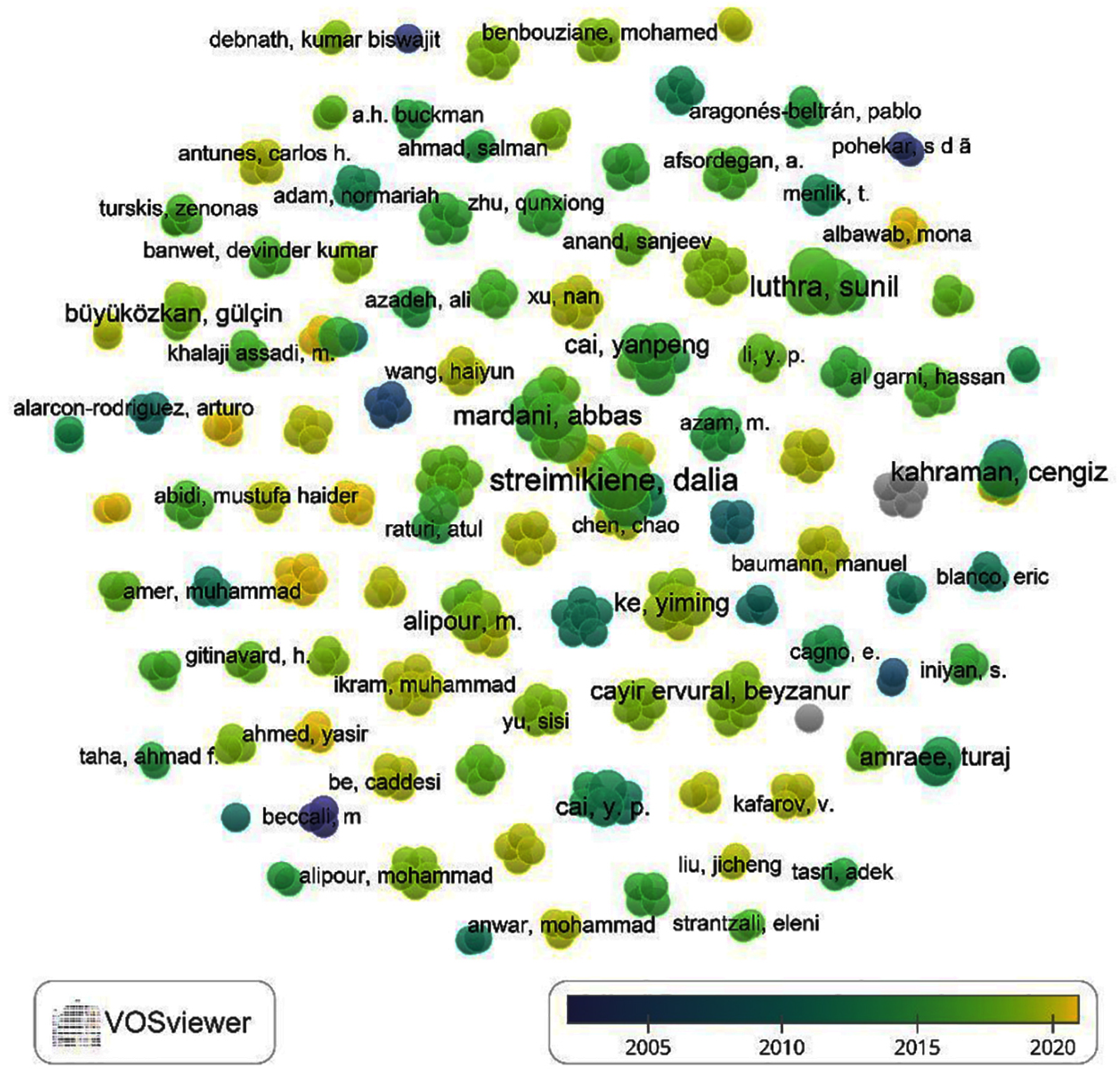
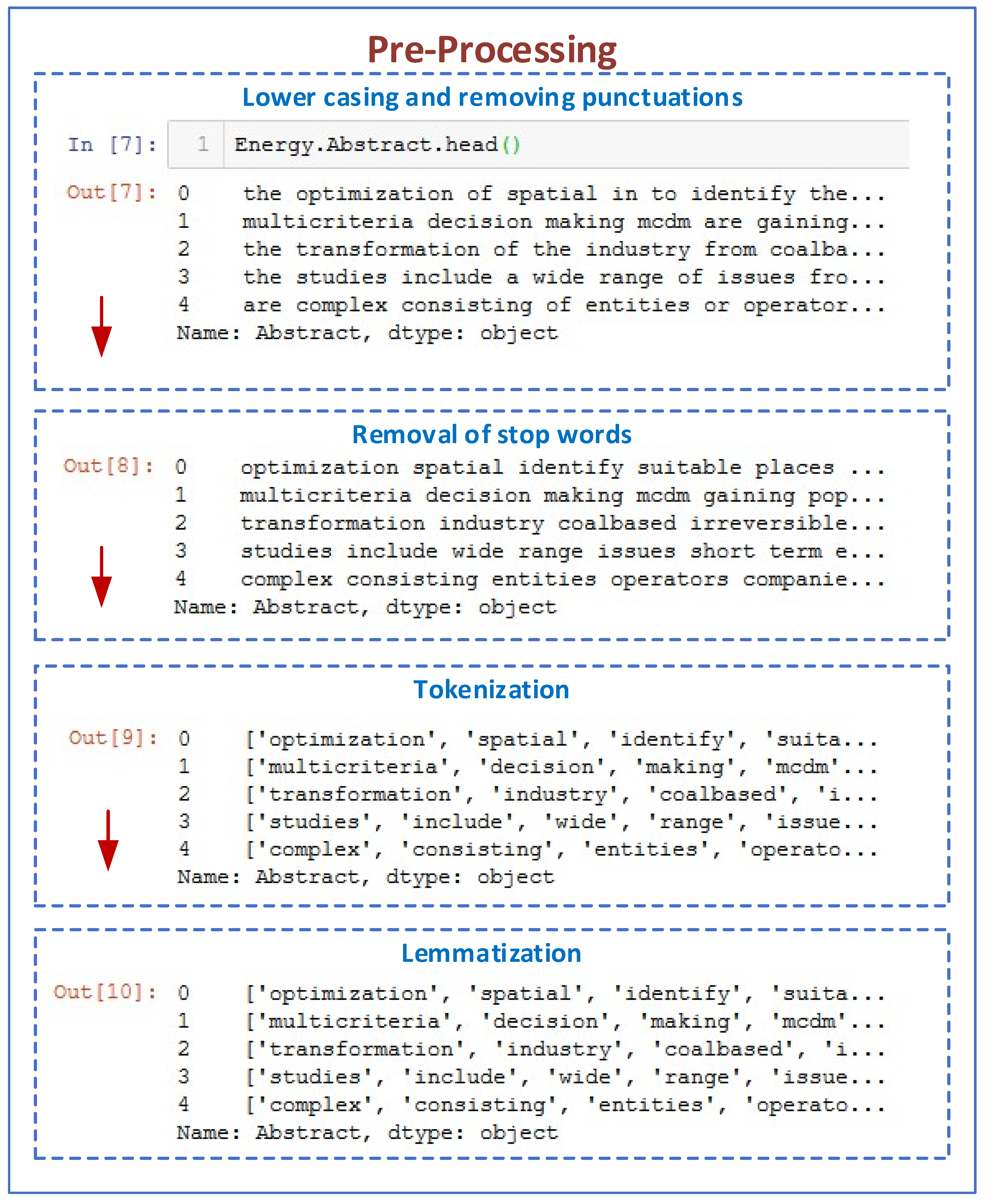
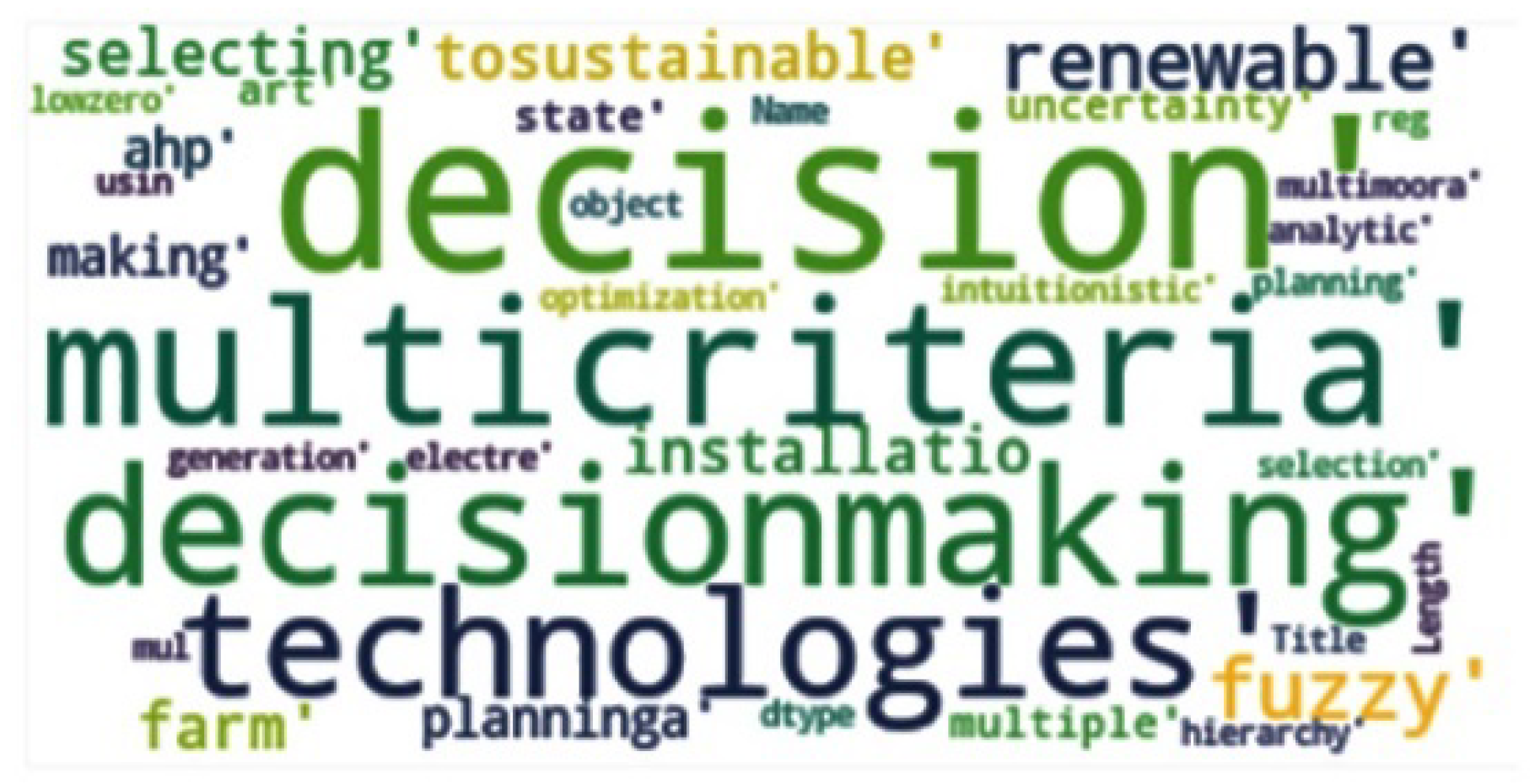

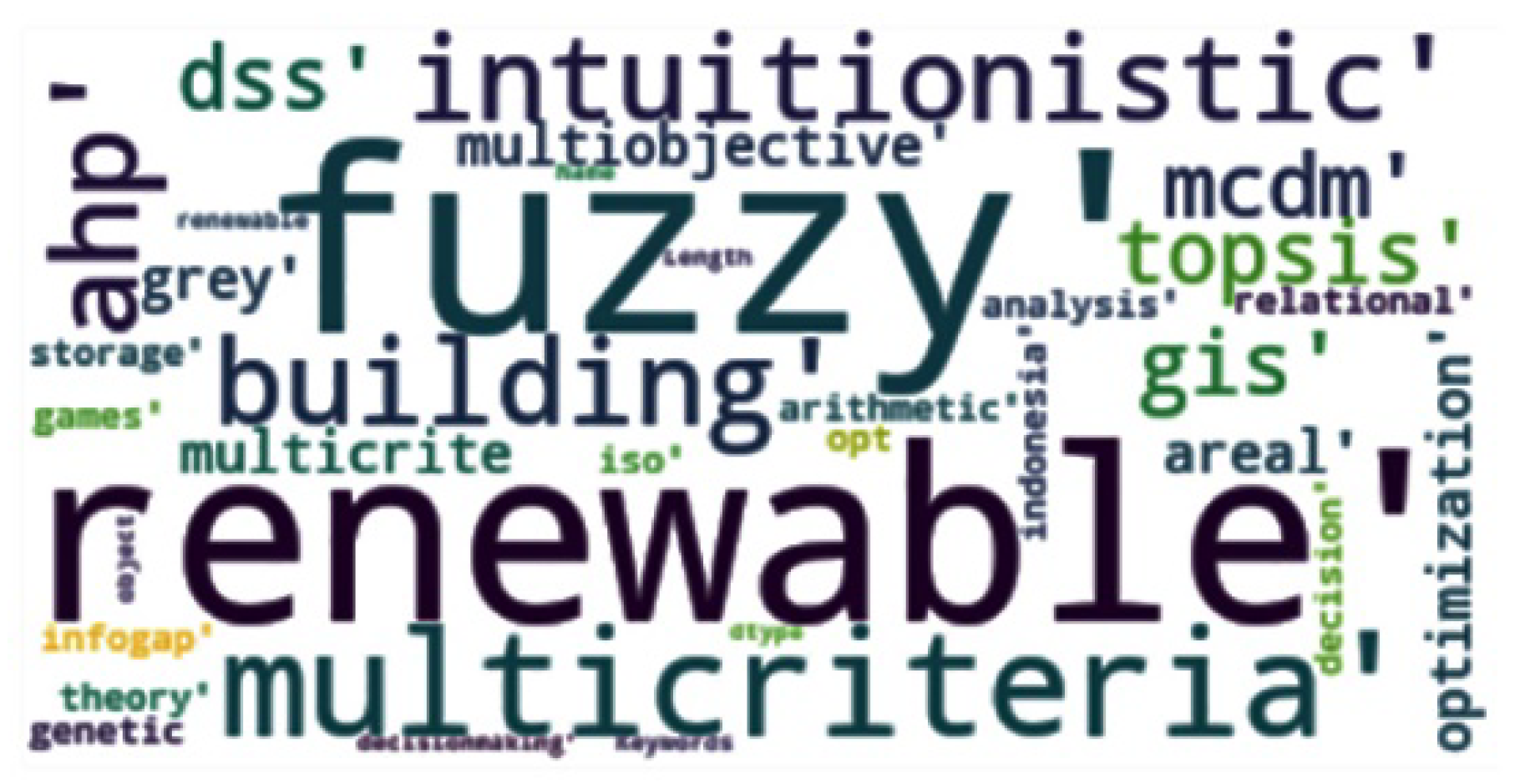
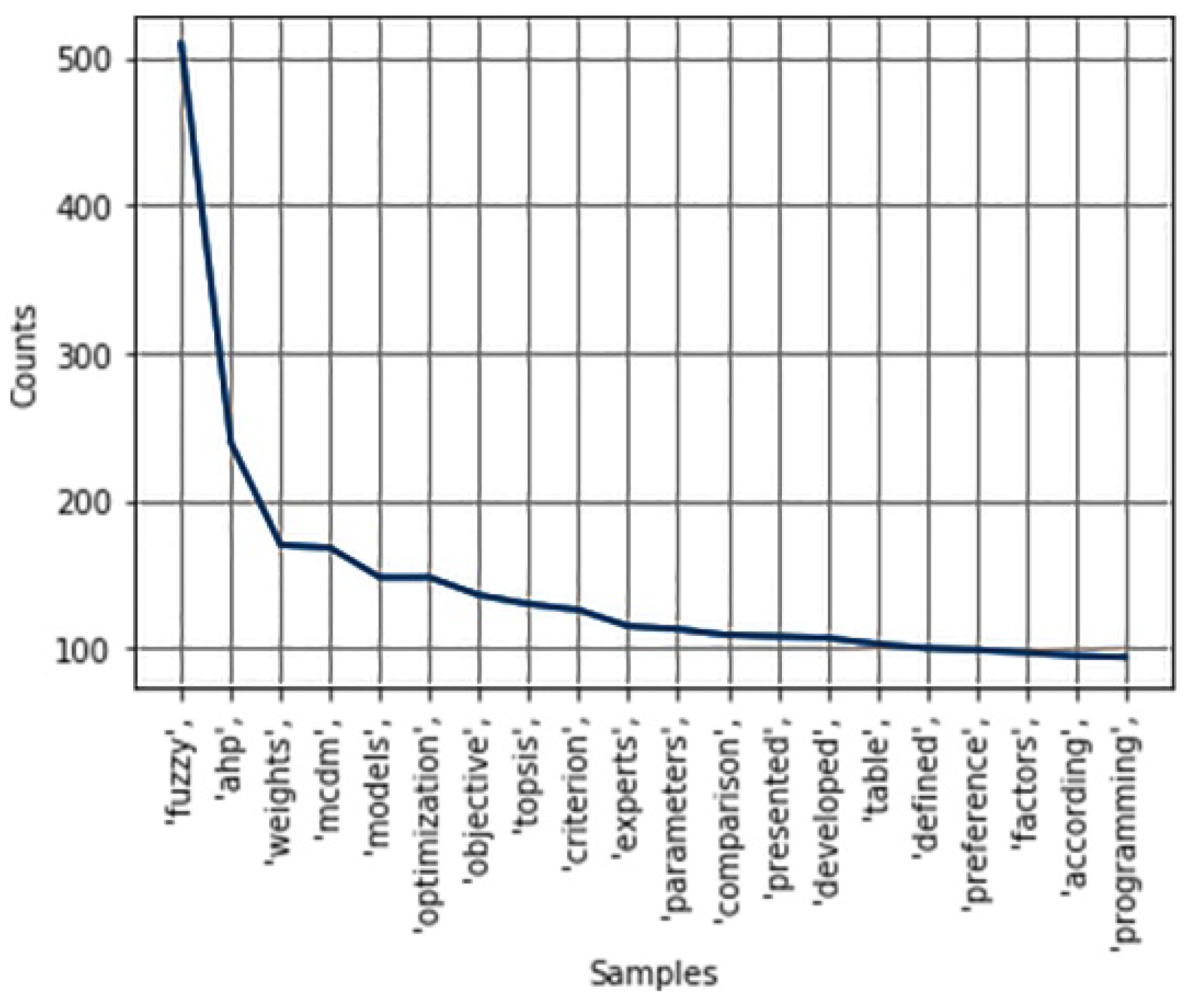

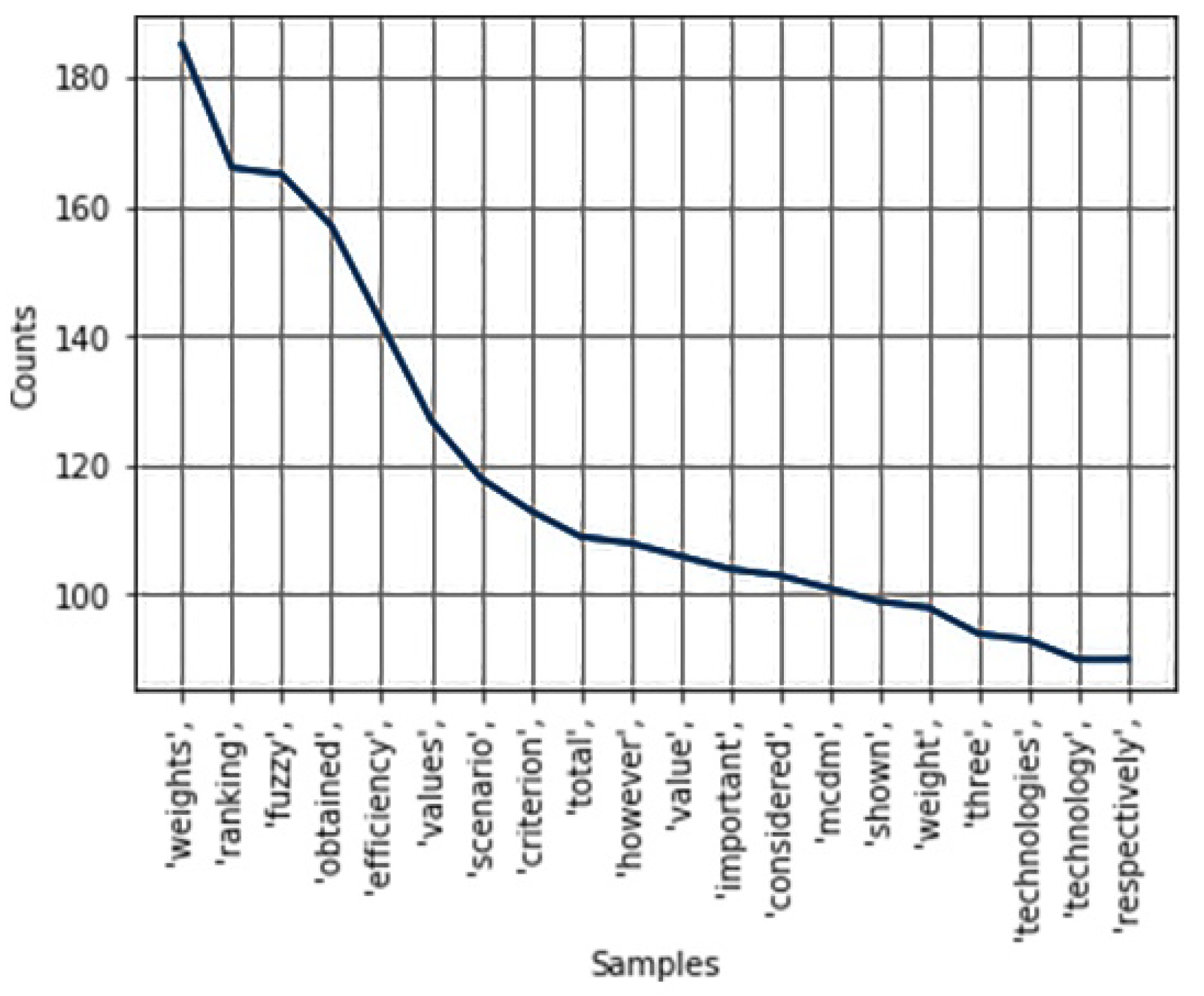




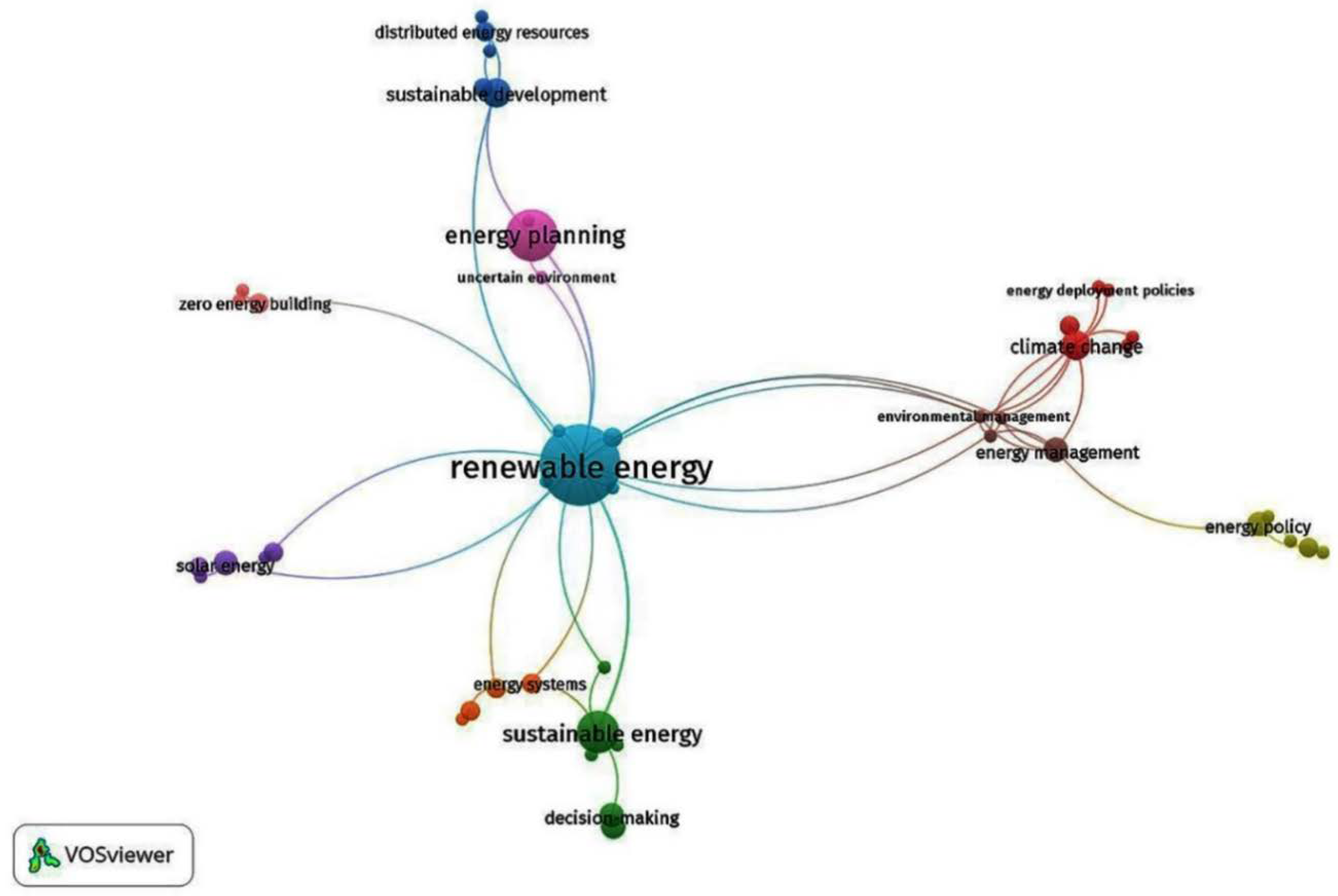
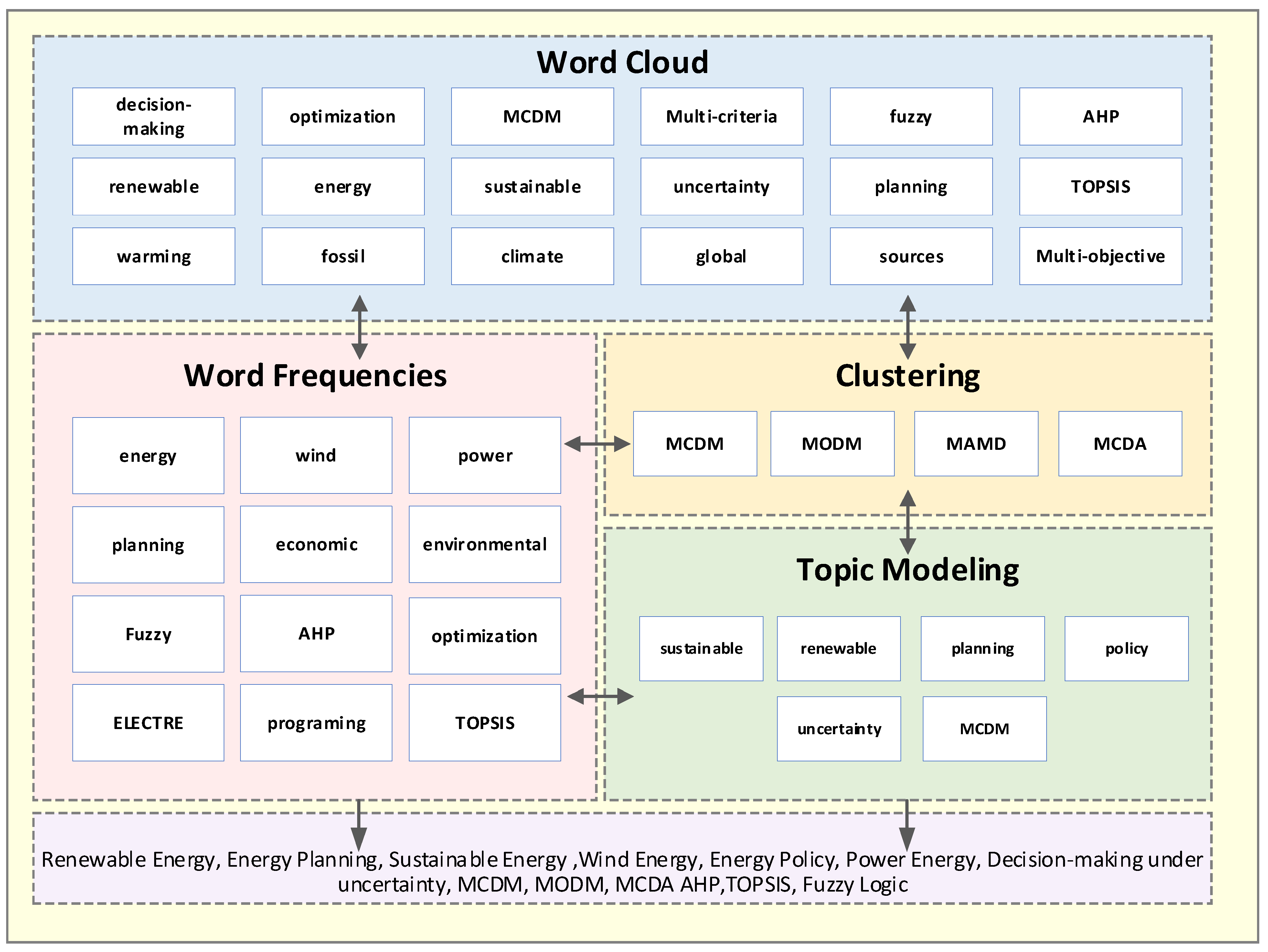
| Journal Name | Number | Impact Factor | h-Index | Q |
|---|---|---|---|---|
| Renewable and Sustainable Energy Reviews | 48 | 10.556 | 222 | Q1 |
| Energy | 13 | 5.537 | 158 | Q1 |
| Energy Policy | 11 | 4.88 | 178 | Q1 |
| Renewable energy | 9 | 5.439 | 157 | Q1 |
| Sustainability | 8 | 2.592 | 53 | Q2 |
| Energy Conversion and Management | 7 | 7.181 | 163 | Q1 |
| Energy economics | 3 | 4.151 | 120 | Q1 |
| International Journal of Energy Sector Management | 3 | 1.14 | 17 | Q2 |
| Sustainable Energy Technologies and Assessments | 2 | 3.456 | 25 | Q1 |
| Sustainable Cities and Society | 2 | 4.624 | 34 | Q1 |
| International Journal of Environmental Science and Technology | 1 | 2.031 | 61 | Q2 |
| Expert Systems with Applications | 1 | 4.292 | 162 | Q1 |
| Applied Soft Computing Journal | 1 | 4.873 | 110 | Q1 |
| Energy and Buildings | 1 | 4.495 | 147 | Q1 |
| Smart and Sustainable Built Environment | 1 | 1.04 | 10 | Q2 |
| Energy Strategy Reviews | 1 | 2.633 | 22 | Q1 |
| Journal of Modern Power Systems and Clean Energy | 1 | 2.848 | 23 | Q1 |
| Energy Sources, Part B: Economics, Planning, and Policy | 1 | 1.093 | 28 | Q2 |
| Management of Environmental Quality: An International Journal | 1 | 1.4 | 29 | Q3 |
| European Journal of Operational Research | 1 | 3.806 | 226 | Q1 |
| IEEE Transactions on Systems, Man, and Cybernetics: Systems | 1 | 7.351 | 111 | Q1 |
| Ocean Engineering | 1 | 2.73 | 80 | Q1 |
| Journal of Intelligent and Fuzzy Systems | 1 | 1.637 | 46 | Q1 |
| Processes | 1 | 1.963 | 16 | Q2 |
| Total | 120 |
| Words/Title | Freq. | Words/Abstracts | Freq. | Words/Keywords | Freq. | Words/Literature Review | Freq. | Words/Methodology | Freq. | Words/Finding and Discussion | Freq. | Words/Conclusion | Freq. |
|---|---|---|---|---|---|---|---|---|---|---|---|---|---|
| ‘energy’ | 80 | ‘energy’ | 538 | ‘energy’ | 102 | ‘energy’ | 2069 | ‘energy’ | 811 | ‘energy’ | 1050 | ‘energy’ | 900 |
| ‘decision’ | 25 | ‘decision’ | 152 | ‘decision’ | 49 | ‘criteria’ | 494 | ‘fuzzy’ | 514 | ‘criteria’ | 411 | ‘criteria’ | 245 |
| ‘renewable’ | 25 | ‘renewable’ | 130 | ‘fuzzy’ | 45 | ‘fuzzy’ | 488 | ‘criteria’ | 503 | ‘decision’ | 222 | ‘renewable’ | 199 |
| ‘sustainable’ | 21 | ‘criteria’ | 108 | ‘making’ | 34 | ‘decision’ | 476 | ‘method’ | 485 | ‘renewable’ | 208 | ‘decision’ | 181 |
| ‘multicriteria’ | 19 | ‘fuzzy’ | 101 | ‘multicriteria’ | 27 | ‘renewable’ | 428 | ‘decision’ | 445 | ‘alternatives’ | 191 | ‘fuzzy’ | 137 |
| ‘making’ | 18 | ‘method’ | 99 | ‘renewable’ | 23 | ‘wind’ | 360 | ‘ahp’ | 240 | ‘weights’ | 189 | ‘sustainable’ | 122 |
| ‘fuzzy’ | 18 | ‘analysis’ | 88 | ‘sustainable’ | 18 | ‘power’ | 345 | ‘analysis’ | 238 | ‘fuzzy’ | 171 | ‘alternatives’ | 99 |
| ‘analysis’ | 17 | ‘sustainable’ | 71 | ‘planning’ | 17 | ‘planning’ | 313 | ‘alternative’ | 218 | ‘analysis’ | 170 | ‘mcdm’ | 98 |
| ‘planning’ | 16 | ‘planning’ | 64 | ‘topsis’ | 14 | ‘mcdm’ | 306 | ‘power’ | 204 | ‘wind’ | 169 | ‘policy’ | 98 |
| ‘decision making’ | 10 | ‘decisionmaking’ | 64 | ‘optimization’ | 14 | ‘system’ | 308 | ‘mcdm’ | 1175 | ‘ranking’ | 166 | ‘environmental’ | 92 |
| ‘multicriteria’ | 9 | ‘alternatives’ | 64 | ‘ahp’ | 13 | ‘analysis’ | 295 | ‘function’ | 165 | ‘solar’ | 148 | ‘decisionmaking’ | 78 |
| ‘uncertainty’ | 8 | ‘multicriteria’ | 57 | ‘decisionmaking’ | 13 | ‘environmental’ | 265 | ‘renewable’ | 156 | ‘power’ | 145 | ‘planning’ | 76 |
| ‘topsis’ | 8 | ‘making’ | 56 | ‘sustainability’ | 13 | ‘alternatives’ | 253 | ‘optimization’ | 148 | ‘efficiency’ | 145 | ‘resources’ | 70 |
| ‘optimization’ | 8 | ‘policy’ | 51 | ‘policy’ | 10 | ‘ahp’ | 251 | ‘objective’ | 136 | ‘economic’ | 133 | ‘ahp’ | 69 |
| ‘decision’ | 6 | ‘makers’ | 45 | ‘programming’ | 9 | ‘decisionmaking’ | 207 | ‘data’ | 135 | ‘policy’ | 118 | ‘topsis’ | 64 |
| ‘ahp’ | 5 | ‘mcdm’ | 41 | ‘mcdm’ | 7 | ‘optimization’ | 196 | ‘evaluation’ | 133 | ‘criterion’ | 116 | ‘uncertainty’ | 58 |
| ‘mcdm’ | 5 | ‘ahp’ | 37 | ‘analytical’ | 7 | optimal | 165 | ‘topsis’ | 130 | ‘mcdm’ | 101 | ‘making’ | 53 |
| ‘sustainability’ | 4 | ‘uncertainty’ | 38 | ‘multiobjective’ | 5 | making | 159 | ‘planning’ | 129 | ‘sustainable’ | 91 | ‘sustainability’ | 49 |
| ‘decisionmaking’ | 4 | ‘optimization’ | 36 | ‘uncertainty’ | 3 | sustainable | 155 | ‘criterion’ | 127 | ‘optimal’ | 87 | ‘optimization’ | 45 |
| Words/Title | Frequency | Words/Title | Frequency |
|---|---|---|---|
| ‘energy’ | 5602 | ‘optimization’ | 509 |
| ‘criteria’ | 1780 | ‘making’ | 480 |
| ‘decision’ | 1533 | ‘topsis’ | 457 |
| ‘fuzzy’ | 1485 | ‘ranking’ | 439 |
| ‘renewable’ | 1186 | ‘multicriteria’ | 375 |
| ‘mcdm’ | 736 | ‘uncertainty’ | 307 |
| ‘planning’ | 709 | ‘criterion’ | 350 |
| ‘sustainable’ | 537 | ‘sustainability’ | 322 |
| ‘decisionmaking’ | 532 | ‘programming’ | 277 |
| ‘policy’ | 527 | ‘uncertain’ | 229 |
| Words | Clusters | Keywords |
|---|---|---|
| Title | Clusters 1 | (AHP, TOPSIS, FAHP, MULTIMOORA, VIKOR, Optimization, Multi-objective, Game theory, Uncertainties, ANP, Fuzzy, Robust, Programming, Bayesian, Multi-attribute, Cognitive map) |
| Clusters 2 | (Delphi-AHP, Fuzzy, TOPSIS, AHP, VIKOR, Goal programming, MULTIMOORA, Multi-criteria) | |
| Keywords | Clusters 1 | (MCDM, AHP TOPSIS, DSS, ROBUST, Delphi, VIKOR, Multicriteria, SWOT, Shannon Entropy, Game theory, uncertainty, fuzzy, PROMETHEE, COPRAS, MOLTIMOORA) |
| Clusters 2 | (Multi-objective, Optimization, Multicriteria, decision- making, uncertainty, modelling, optimized, Multicriteria, MCDM, MOLTIMOORA, Optimization, Bayesian, multiple, uncertainties, MCDM, MADM, ELECTRE, ARAS) | |
| Clusters 3 | (Linear, Programming, Optimization, Uncertain, MILP, Single-objective, optimization, Multi-objective) | |
| Abstract | Clusters 1 | (Optimization, AHP, TOPSIS, SWOT, VIKOR, Delphi, Fuzzy, Multi-criteria, Decision-making, MCDA, FANP, ISM, ELECTRE, PROMETHEE, FPROMETHEE) |
| Clusters 2 | (Fuzzy TOPSIS, VIKOR, MOLTIMOORA, Optimization, Multi-objective, Genetic algorithm, Single, Objective, Optimization, Fuzzy logic, ELECTRE iii, MADM, AHP, Multi-attribute, FCM, robustness, uncertainties, Goal programming, ANN, DEA, TODIM, FPROMETHEE, Fuzzy Rough, Delphi Group decision-making, Robust, Linear programming, FAHP) | |
| Research Methodology | Clusters 1 | (Fuzzy, AHP, SWOT, Group decision-making, Cognitive map, TOPSIS) |
| Clusters 2 | (AHP, Multi-criteria, MCDM, Uncertainty, ELECTRE iii, Game-theoretic, Optimization, MADM, Goal programming, Multi-objective, Fuzzy logic, MCDA, FCM, Robustness, VIKOR, Mathematical, Shannon entropy, PROMETHEE, ANP, Programming, Goal programming, Dynamic programming) |
| Topic | Topic Words | |
|---|---|---|
| Title | Topic 1 | (‘hierarchy’, ‘analytic’, ‘fuzzy’, ‘using’, ‘selection’) |
| Topic 2 | (‘fuzzy’, ‘forecasting’, ‘planning’, ‘decision-making’, ‘multi-objective’) | |
| Topic 3 | (‘multicriteria’, ‘decision-making’, TOPSIS) | |
| Topic 4 | (‘prioritizing’, ‘optimization’, ‘multiple’, ‘sustainable’, ‘renewable’) | |
| Topic 5 | (‘review’, ‘optimization’, AHP) | |
| Topic 6 | (‘decision’, ‘review’, TOPSIS, ‘uncertainty’, ‘qualitative’) | |
| Keywords | Topic 1 | (‘technologies’, ‘decision-making’, ‘renewable’, ‘multicriteria’, ‘programming’) |
| Topic 2 | (‘planning’, ‘renewable’, ‘multiple’, ‘development’, ‘sustainable’) | |
| Topic 3 | (‘analytic’, ‘hierarchy’, ‘programming’, ‘making’, VIKOR) | |
| Topic 4 | (‘sustainable’, ‘production’, ‘multicriteria’, ‘optimization’, ‘systems’) | |
| Topic 5 | (‘analysis’, ‘power’, ‘fuzzy’, ‘uncertainty’, ‘optimization’) | |
| Topic 6 | (‘policy’, ‘assessment’, ‘analytic’, ‘methods’, ‘renewable’) | |
| Topic 7 | (‘sustainable’, ‘distributed’, ‘fuzzy’, DEA, ‘multi-objective’) | |
| Research Methodology | Topic 1 | (MCDM, ‘Alternatives’, ‘Programming’, ‘ranking’, PROMETHEE, ‘Uncertainty’, Optimal) |
| Topic 2 | (FCM) | |
| Topic 3 | (DEA, FAHP, FPROMETHEE) | |
| Topic 4 | (Rough) | |
| Topic 5 | (Fuzzy, AHP, optimization, TOPSIS, decision-making, multicriteria, ANP) | |
| Topic 6 | (Shannon entropy) | |
| Topic 7 | (TODIM, MADA, PROMETHEE ii) | |
| Topic 8 | (MOORA) |
© 2020 by the authors. Licensee MDPI, Basel, Switzerland. This article is an open access article distributed under the terms and conditions of the Creative Commons Attribution (CC BY) license (http://creativecommons.org/licenses/by/4.0/).
Share and Cite
Tavana, M.; Shaabani, A.; Javier Santos-Arteaga, F.; Raeesi Vanani, I. A Review of Uncertain Decision-Making Methods in Energy Management Using Text Mining and Data Analytics. Energies 2020, 13, 3947. https://doi.org/10.3390/en13153947
Tavana M, Shaabani A, Javier Santos-Arteaga F, Raeesi Vanani I. A Review of Uncertain Decision-Making Methods in Energy Management Using Text Mining and Data Analytics. Energies. 2020; 13(15):3947. https://doi.org/10.3390/en13153947
Chicago/Turabian StyleTavana, Madjid, Akram Shaabani, Francisco Javier Santos-Arteaga, and Iman Raeesi Vanani. 2020. "A Review of Uncertain Decision-Making Methods in Energy Management Using Text Mining and Data Analytics" Energies 13, no. 15: 3947. https://doi.org/10.3390/en13153947
APA StyleTavana, M., Shaabani, A., Javier Santos-Arteaga, F., & Raeesi Vanani, I. (2020). A Review of Uncertain Decision-Making Methods in Energy Management Using Text Mining and Data Analytics. Energies, 13(15), 3947. https://doi.org/10.3390/en13153947





